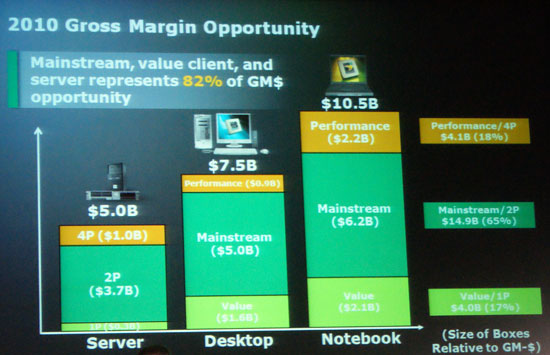The RV770 Story: Documenting ATI's Road to Success
by Anand Lal Shimpi on December 2, 2008 12:00 AM EST- Posted in
- GPUs
Building a GPU for the Masses
AMD put up this graph at its recent Financial Analyst Day:

The performance segment of the desktop CPU market is only about 7% of the pie and although it generates a disproportionately large amount of revenue it’s neither the biggest segment nor the biggest revenue generator in the market. That would be the mainstream segment.
ATI realized much of the same thing back in 2005. These high end GPUs were getting more and more expensive, while R300 tipped the scales at $399 over the coming years we’d see GPUs hit $499, $599 and go north of $600 at launch. The higher prices were due to increasing die sizes and techniques such as harvesting, ensuring that regardless of how big the GPU, revenues were protected.
A $399 R300 was close enough to the mainstream price points that ATI was able to scale it down months later to address other markets, but these days the time between the high end GPU introduction and the mainstream revisions of it has increased to 6 - 9 months. We still don’t have a mainstream derivative of NVIDIA’s GT200 architecture and chances are that we won’t until around 9 months after its introduction. With the GeForce GTX 280 launching at $600, for it to take 9 months to make a $200 derivative is doing the market a disservice in ATI’s eyes.
It was time to refocus. Instead of tailoring to the needs of the high end, ATI wanted to make a product that would be the best in the $200 - $300 range. To do so would mean that it would have to reverse the strategy that made it successful to begin with, and hope that somehow NVIDIA wouldn’t follow suit.










116 Comments
View All Comments
n7 - Wednesday, December 3, 2008 - link
These kind of articles are why i love AT.Fantastic read, thanx!
glynor - Wednesday, December 3, 2008 - link
Thanks Anand. It is things just like this that have kept me coming back for years and year. Great work!jah128 - Wednesday, December 3, 2008 - link
Really good article, one of the best I've read here.doittoit - Wednesday, December 3, 2008 - link
Don't forget what rv770 did to GTX 280. Made it completely irrelevent. 2 x 4850 made it so no-one would ever bother with nvidia's "monster". Now they just have to get over the hump on driver support. Down with NVIDIA!!Element81 - Wednesday, December 3, 2008 - link
Best article I've read on your site in a long time. I crave all the performance benchmarks and reviews of new products but the back story behind the creation of the RV770 is amazing. I will be building myself a new rig very soon and I've been following hardware religiously in the last few months to help me make my decision. A new 4850 or 4870 will def end up in my new build.BernardP - Wednesday, December 3, 2008 - link
Thanks for this great article. Well-written and full of new information.truk007 - Wednesday, December 3, 2008 - link
This article is the best I've read on any tech site. Loved it! I hope Anandtech has more behind-the-scenes stories like this again, and I also hope that companies continue to give these types of interviews. It was a great journalistic piece that made the company all that much more human. Thanks!rwei - Wednesday, December 3, 2008 - link
I've been reading for 2-3 years and was too lazy to comment...but I found this article compelling enough to create an account just to say how much I liked it =)For a student studying both compsci and business/mgmt, the dual focus on engineering and business challenges was very interesting. Though there was a very obvious potential for a "rah-rah ATI!" bias given the nature of the interview, especially when discussing R600.
WeaselITB - Wednesday, December 3, 2008 - link
There must be echos in here, because I'm adding my words to the mix. In the roughly-10 years that I've been reading AnandTech (yes, I remember reading the Celeron "launch" article and the whole celery jokes that went with it), I must say that this is one of the best articles I've read here.It's articles like this that keep me coming back to AT all these years. Everyone and their dog can benchmark and put up pretty graphs (no offense, Derek), but it's the meaty articles like this one that give AT that leg-up over the competition.
Thanks, Anand, for an awesome ten years, and here's to ten more!
Goty - Wednesday, December 3, 2008 - link
On page 2, when discussing the Radeon 8500, you have to remember that the 8500's intended competition was the GeForce 3 series, against which it was fairly competitive (especially at the end of its life). ATI never really released a product to compete with the GeForce 4 cards.